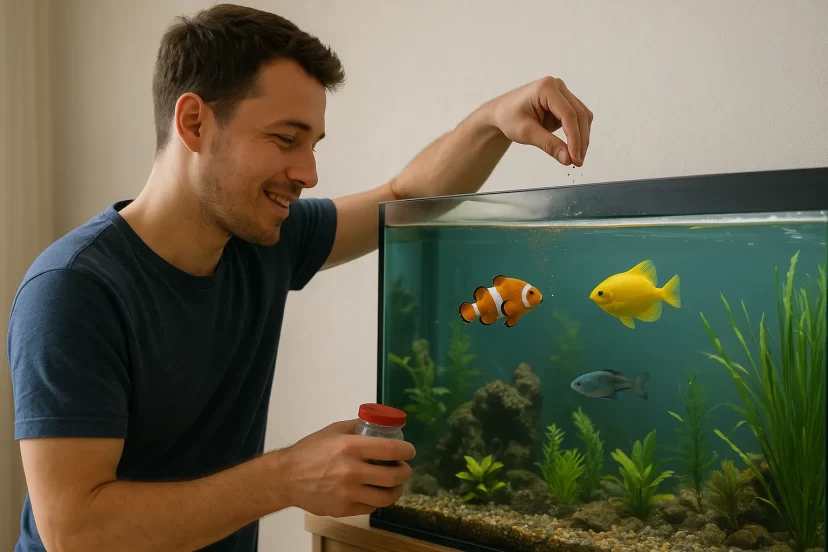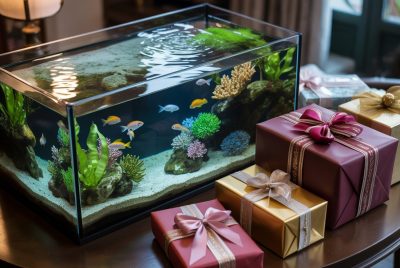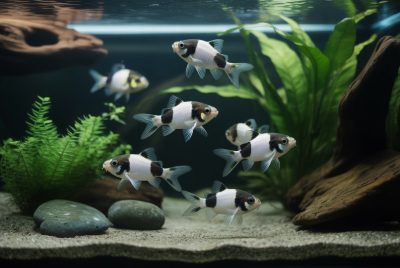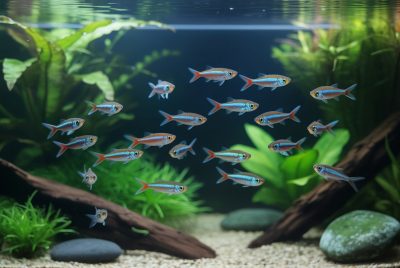Overfeeding Fish: Signs, Risks, and Solutions
*We may earn a commission for purchases made using our links. Please see our disclosure to learn more.
The gentle hum of the aquarium filter fills the room as colorful fish glide through crystal-clear water. This peaceful scene can quickly turn into an aquatic nightmare when well-meaning fish owners make one of the most common mistakes in fishkeeping: overfeeding. The consequences ripple through the entire ecosystem, affecting water quality, fish health, and the delicate balance that makes an aquarium thrive.
Understanding the signs of overfeeding, recognizing its serious risks, and implementing effective solutions can mean the difference between a thriving aquatic environment and a struggling ecosystem. This comprehensive guide explores the complex relationship between feeding practices and aquarium health, offering practical insights for maintaining the perfect balance.
“The biggest mistake new aquarium owners make is thinking that more food equals healthier fish. In reality, less is almost always more when it comes to feeding aquatic pets.”
– Marine Biology Research Institute
Key Takeaways
- Overfeeding is the leading cause of aquarium problems, affecting water quality and fish health
- Fish can survive much longer without food than with too much food – most species can go 3-7 days without eating
- The “5-minute rule” is outdated – fish should consume all food within 2-3 minutes
- Water quality deterioration happens rapidly when excess food decomposes in the tank
- Prevention through proper feeding schedules is far easier than correcting overfeeding damage
- Different fish species have vastly different nutritional requirements and feeding frequencies
Understanding the Overfeeding Problem
The Root of Good Intentions
Many aquarium enthusiasts enter the hobby with the best intentions. The desire to care for aquatic pets often translates into frequent feeding sessions, thinking that well-fed fish are happy fish. This misconception stems from our mammalian perspective, where regular meals are essential for health and comfort.
However, fish have fundamentally different metabolic systems. Their cold-blooded nature means they require significantly less food than warm-blooded animals. Additionally, their digestive systems are designed to process food slowly and efficiently, making frequent feeding unnecessary and potentially harmful.
The Cascade Effect
When fish receive more food than they can consume, the excess doesn’t simply disappear. Uneaten food begins decomposing immediately, releasing ammonia and other toxic compounds into the water. This process creates a cascade of problems that can quickly spiral out of control.
The decomposition process consumes oxygen, reducing the available dissolved oxygen that fish need to breathe. Simultaneously, harmful bacteria populations explode, further compromising water quality and potentially introducing disease-causing pathogens into the environment.
Recognizing the Warning Signs
Physical Indicators in Fish
Overfed fish display several telltale signs that observant aquarium owners can identify early. Bloated appearances, particularly around the belly area, indicate that fish have consumed more than their digestive systems can handle efficiently. This bloating can be temporary after a large meal or persistent in cases of chronic overfeeding.
Lethargy represents another clear indicator. Overfed fish often become sluggish, spending more time resting on the bottom of the tank or hiding among decorations. Their swimming patterns may become erratic, and they might show less interest in their surroundings or tank mates.
Changes in excrement also signal overfeeding issues. Healthy fish produce minimal, well-formed waste. Overfed fish typically produce excessive amounts of waste, often with unusual colors or consistencies that indicate digestive stress.
Environmental Warning Signs
The aquarium environment itself provides numerous clues about overfeeding problems. Cloudy water represents one of the most obvious indicators, as bacterial populations bloom in response to excess nutrients from decomposing food.
Algae growth accelerates dramatically in overfed tanks. While some algae is normal and even beneficial, sudden explosions of green, brown, or blue-green algae often correlate directly with overfeeding incidents. These algae blooms can quickly overwhelm filtration systems and create an unsightly, unhealthy environment.
Unusual odors emanating from the tank indicate serious problems. Healthy aquariums should have little to no smell, while overfed tanks often develop musty, fishy, or sulfur-like odors as organic matter decomposes.
The Hidden Risks of Overfeeding
Water Chemistry Disasters
Overfeeding creates a domino effect of water chemistry problems that can prove fatal to aquatic life. Ammonia levels spike as uneaten food and excess waste decompose, creating toxic conditions that stress fish immune systems and damage delicate gill tissues.
The nitrogen cycle, which normally processes waste products safely, becomes overwhelmed when faced with excessive organic matter. Nitrite levels can reach dangerous concentrations, interfering with fish’s ability to transport oxygen in their bloodstreams. Even when the cycle catches up, elevated nitrate levels can cause long-term health problems and promote unwanted algae growth.
pH fluctuations often accompany overfeeding situations as decomposing organic matter releases acids into the water. These sudden changes in pH can shock fish, damage their protective slime coats, and create conditions favorable for disease-causing organisms.
Disease and Mortality Risks
Overfed fish face significantly higher risks of developing various diseases and health complications. Weakened immune systems, stressed by poor water quality and digestive overload, cannot effectively fight off bacterial, fungal, or parasitic infections that opportunistically attack compromised hosts.
Swim bladder disorders frequently affect overfed fish, causing them to lose buoyancy control and struggle with normal swimming behaviors. These conditions can be temporary or permanent, depending on the severity and duration of overfeeding.
Fatty liver disease develops in chronically overfed fish, particularly in species prone to this condition. This serious health problem can cause organ failure and death, often without obvious external symptoms until the condition has progressed significantly.
Ecosystem Collapse
Severe overfeeding can trigger complete aquarium ecosystem collapse. As water quality deteriorates, beneficial bacteria die off, filtration systems become overwhelmed, and the entire biological balance that maintains a healthy aquarium disintegrates.
Recovery from ecosystem collapse requires extensive intervention, including massive water changes, filter media replacement, and often the temporary removal of fish to hospital tanks. Many fish don’t survive this process, making prevention through proper feeding practices essential.
Developing Proper Feeding Solutions
Establishing Feeding Schedules
Creating and maintaining consistent feeding schedules forms the foundation of proper aquarium nutrition. Most adult fish thrive on once-daily feeding, while juvenile fish may require twice-daily meals to support their growth and development.
The timing of feeding sessions can significantly impact their effectiveness. Many aquarium owners find success with morning feedings, allowing fish to process food throughout their most active daylight hours. Evening feedings should be avoided, as fish metabolism slows during nighttime periods.
Feeding schedules should account for natural fish behaviors and species-specific requirements. Some fish are natural grazers that benefit from small, frequent meals, while others are adapted to consume larger meals less frequently.
Portion Control Strategies
Determining appropriate portion sizes requires careful observation and adjustment based on fish behavior and tank conditions. The traditional “five-minute rule” has been replaced by more conservative guidelines recommending that all food be consumed within two to three minutes.
Visual cues provide the most reliable method for determining proper portions. Fish should appear eager for food at feeding time but not frantic. After eating, they should resume normal swimming patterns without appearing bloated or lethargic.
Species-specific requirements vary significantly. Large predatory fish may consume substantial meals every few days, while small tropical fish require tiny amounts of food daily. Research each species’ natural feeding patterns to develop appropriate portioning strategies.
Food Quality and Variety
High-quality foods provide better nutrition in smaller quantities, reducing waste and improving water quality. Premium fish foods contain more digestible proteins and fewer fillers, meaning fish require less food to meet their nutritional needs.
Variety in diet prevents nutritional deficiencies and maintains fish interest in feeding. Rotating between high-quality flakes, pellets, frozen foods, and occasional live treats provides balanced nutrition while preventing fish from becoming finicky eaters.
Storage and handling of fish food significantly impact its nutritional value and digestibility. Properly stored foods maintain their nutritional content and produce less waste when consumed, while degraded foods can actually contribute to water quality problems.
Recovery and Remediation
Immediate Response Strategies
When overfeeding has already occurred, quick action can prevent minor problems from becoming major disasters. Removing visible uneaten food immediately prevents further decomposition and reduces the organic load on the filtration system.
Testing water parameters provides crucial information for determining the extent of the problem and guiding remediation efforts. Ammonia, nitrite, and nitrate levels indicate the severity of water quality degradation and help prioritize intervention strategies.
Partial water changes represent the most effective immediate response to overfeeding incidents. Removing 25-50% of tank water and replacing it with properly conditioned fresh water quickly dilutes toxins and provides temporary relief for stressed fish.
Long-term Recovery Protocols
Extended recovery from serious overfeeding incidents requires patience and consistent effort. Daily water testing and regular partial water changes may be necessary for weeks to restore proper water chemistry and biological balance.
Filtration system maintenance becomes crucial during recovery periods. Filter media may require frequent cleaning or replacement as beneficial bacteria populations reestablish and excess organic matter is processed.
Fish health monitoring intensifies during recovery phases. Observing fish behavior, appetite, and physical condition helps identify potential disease issues early, when treatment is most likely to be successful.
Species-Specific Considerations
Tropical Community Fish
Popular tropical species like tetras, guppies, and mollies have relatively high metabolisms but small stomach capacities. These fish benefit from small, frequent meals rather than large feeding sessions. Their active nature means they process food quickly, but they can also consume food rapidly, making portion control especially important.
Community tanks with mixed species present unique challenges, as different fish have varying nutritional requirements and feeding behaviors. Some species are aggressive feeders that monopolize food, while others are shy and may not compete effectively for meals.
Goldfish and Koi
These hardy species are notorious for their voracious appetites and begging behaviors, making them particularly susceptible to overfeeding. Their digestive systems are designed to process plant matter continuously, but commercial foods are often much richer than their natural diet.
Cold-water species like goldfish have slower metabolisms than tropical fish, requiring less frequent feeding and smaller portions. During cooler months, their feeding requirements decrease significantly as their metabolism slows further.
Predatory and Large Fish
Large predatory fish like cichlids, catfish, and marine species have different feeding patterns than smaller community fish. These species often consume large meals infrequently, mimicking their natural hunting and feeding behaviors.
Understanding natural feeding cycles helps prevent overfeeding of predatory species. Many large fish can comfortably go several days between meals, and attempting to feed them daily often leads to overfeeding problems.
Technology and Tools
Automated Feeding Systems
Modern automatic feeders can help maintain consistent feeding schedules and portion control, particularly for busy aquarium owners. However, these devices require careful calibration and regular monitoring to prevent mechanical overfeeding incidents.
Quality automatic feeders include portion control mechanisms and moisture protection features that maintain food quality. Programming these devices requires understanding of species-specific feeding requirements and regular adjustment based on fish growth and seasonal changes.
Monitoring Equipment
Water testing equipment provides objective data about tank conditions and helps identify overfeeding problems before they become serious. Digital test kits offer accuracy and convenience, while traditional liquid test kits provide reliable results at lower costs.
pH monitors, ammonia alerts, and nitrate test strips can provide early warning of developing problems. Regular testing schedules help establish baseline parameters and quickly identify deviations that may indicate overfeeding issues.
Building Sustainable Feeding Practices
Long-term Success Strategies
Sustainable feeding practices develop through experience, observation, and adjustment. Keeping feeding logs helps track portion sizes, feeding frequencies, and fish responses, providing valuable data for optimizing nutrition programs.
Environmental factors influence feeding requirements throughout the year. Water temperature, lighting cycles, and seasonal changes all affect fish metabolism and feeding behavior, requiring adjustments to feeding practices.
Community and Education
Connecting with experienced aquarium keepers provides valuable insights and support for developing proper feeding techniques. Local aquarium clubs, online forums, and social media groups offer platforms for sharing experiences and learning from others’ successes and mistakes.
Continuing education about aquarium nutrition and fish biology helps aquarium owners make informed decisions about feeding practices. Understanding the science behind fish nutrition enables better problem-solving and prevents common mistakes.
The Path Forward
Creating a thriving aquarium environment requires balancing fish nutrition with ecosystem health. Proper feeding practices form the cornerstone of successful fishkeeping, influencing every aspect of aquarium management from water quality to fish behavior.
The journey toward mastering aquarium feeding techniques continues throughout an aquarist’s experience. Each species presents unique challenges and learning opportunities, while advancing technology and research provide new tools and insights for optimizing fish care.
Success in aquarium feeding comes from understanding that less is often more, that observation trumps assumption, and that patience yields better results than quick fixes. Fish have survived millions of years by adapting to feast-and-famine cycles, making them remarkably resilient to occasional missed meals but vulnerable to the constant abundance that overfeeding provides.
Conclusion
Overfeeding represents one of the most common yet preventable problems in aquarium keeping. By recognizing the warning signs early, understanding the serious risks involved, and implementing proven solutions, aquarium enthusiasts can create thriving aquatic environments that support healthy, long-lived fish.
The key lies in shifting perspective from mammalian feeding patterns to understanding fish biology and natural behaviors. Fish thrive on consistency rather than abundance, quality rather than quantity, and proper timing rather than frequent feeding.
Success comes through careful observation, gradual adjustments, and the patience to allow natural biological processes to maintain aquarium balance. The reward for this thoughtful approach is an aquatic ecosystem that provides years of enjoyment while supporting the health and wellbeing of its inhabitants.
Remember that every aquarium is unique, every fish species has specific requirements, and every feeding decision impacts the entire ecosystem. By approaching fish nutrition with knowledge, respect, and careful attention to detail, aquarium owners can avoid the pitfalls of overfeeding while providing optimal care for their aquatic companions.
Frequently Asked Questions
Q: How long can fish safely go without food?
A: Most healthy adult fish can safely go 3-7 days without food, with some species able to fast for up to two weeks. Fry and juvenile fish have higher metabolic needs and should not go more than 1-2 days without feeding. This natural fasting ability makes fish much more tolerant of underfeeding than overfeeding.
Q: How do I know if I’m feeding the right amount?
A: Fish should consume all food within 2-3 minutes of feeding. If food remains after this time, you’re likely overfeeding. Fish should appear eager at feeding time but not frantic, and should resume normal swimming patterns after eating without appearing bloated. Water should remain clear, and you shouldn’t notice increased waste or unusual odors.
Q: What should I do if I accidentally overfeed my fish?
A: Remove any visible uneaten food immediately using a net or siphon. Test water parameters, particularly ammonia and nitrite levels. Perform a 25-50% water change if parameters are elevated. Skip the next feeding and monitor fish behavior closely. Consider feeding smaller portions for the next several days while water quality stabilizes.
Q: Do different fish species require different feeding schedules?
A: Yes, feeding requirements vary significantly between species. Small tropical fish typically need daily feeding, while large predatory fish may eat every 2-3 days. Bottom feeders often require sinking foods, while surface feeders need floating options. Research your specific species’ natural feeding behaviors and adjust accordingly.
Q: Can overfeeding kill fish, and how quickly?
A: Yes, overfeeding can be fatal through multiple mechanisms. Acute overfeeding can cause immediate digestive blockages or swim bladder problems. More commonly, chronic overfeeding leads to poor water quality that can kill fish within days to weeks. The decomposition of excess food creates toxic ammonia spikes that can be lethal, especially in smaller tanks with limited biological filtration capacity.




